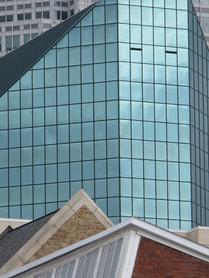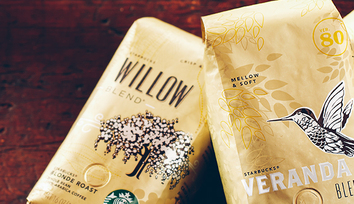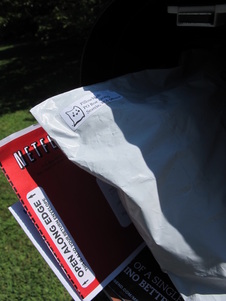 Part of Winston-Salem, N.C. skyline
Part of Winston-Salem, N.C. skyline Early on, Winston-Salem was known as Camel City (hard to imagine, eh?). Later, it was The World’s Tobacco Metropolis (1932). Other attempts that didn’t focus on the business of its famous namesake have included The City of Historic Charm and Thriving Industry and The City of Culture, History and Industry. More recently, Winston-Salem was City of the Arts (later expanded to City of the Arts & Innovation) and O! Winston-Salem, Now That’s Living. The only good thing about O! Winston-Salem, which reportedly cost city fathers $65,000, was that it quickly faded away after some well-deserved snickering. The City of Arts and Innovation is appealing but too narrowly focused.*
So now Winston-Salem has thrown up its hands and asked the folks who live there to come up with something. Good idea! And since my family and I have lived in the city twice over the years and reside today in its western suburbs, here’s my 2-cents worth on developing a tagline for Winston-Salem -- or any city or region, for that matter:
Taglines answer Strategic questions.
Here are key questions to ask of a city and its people during tagline deliberations:
· Why should I want to live here – or raise my family here?
· How is “my” city different from other cities of similar or different size?
· Why should I want to locate my business here?
· How does this city answer these questions today?
· How will it answer them in the future; what is its vision (dream with a goal)?
tagline effectiveness.
· declares clear strategic space (as exclusive as possible)
· is authentic (grounded in Marketable Truth©)
· is meaningful (speaks directly to people’s needs and wants)
· is compelling (engages mind and heart)
· is simple (uses as few words as possible)
· is visual (attracts eye and ear)
· is memorable (sometimes even in a bold or controversial way
· is not distractingly clever or cute
I believe that taglines should make clear, unambiguous benefits statements. Unfortunately, most of them don’t. Even some clever, memorable ones.
“Virginia is for Lovers” sounds great but actually says little. At heart, it’s a great campaign theme but not effective strategic positioning for the long run (despite its continuing appeal for something like 50 years). Same for the “Big Apple” – although after spending gazillions on promotion, now even the dimmest bulb in the world is aware of The Big Apple. However, does the tagline make you think about wanting to live there? Or move your business to New York City? There’s a big difference between awareness and preference.
So, what is so unique and compelling about Winston-Salem, North Carolina that people who hear about it will want to check it out? Here are some tagline building blocks, Winston-Salem superlatives, as I see them:
· not too big, not too small (5th largest city in N.C.)
· pleasant topography (rolling hills with lots of trees – very green)
· easy to get around (short commutes, minimal traffic hassles)
· well-established, walkable neighborhoods – plus new developments in and out of town
· four balanced seasons (moderate winters, good rain, fabulous autumn colors)
· a great place for home and family
· a value-priced, stable real estate market
· a rich sense of history and place, since 1766 (Old Salem historic district, Moravian heritage)
· a healthy mix of natives and newcomers
· a somewhat conservative political base with a forward looking, can-do business approach
· a strong work ethic in a right-to-work state, from traditional manufacturing to high tech
· a leading teaching hospital and research center affiliated with Wake Forest University
· a second well-regarded hospital (Forsyth Medical Center) and associated Novant practices
· a reputation for innovation and business incubation (Winston-Salem Research Park)
· headquarters for the nation’s 12th largest bank (BB&T)
· headquarters for R.J. Reynolds Tobacco Company, HanesBrands and Sara Lee Hosiery
· the mini-Empire State Building (old RJR headquarters used as a model for the NYC skyscraper)
· in-town Smith Reynolds airport (INT) for convenient executive travel
· nearby Triad International Airport (GSO), with its growing aviation hub (Timco, HondaJet)
· intersection of two interstate highways, I-74 and I-40 (two others close by)
· less than two hours to Raleigh and Charlotte, six to Atlanta and D.C.
· around four hours to NC and SC beaches, including North Carolina’s Outer Banks
· less than one hour to the Blue Ridge Parkway in Virginia, about 2 hours to Asheville
· other High Country attractions close by, including golf, skiing, arts & crafts
· many Yadkin Valley wineries a half hour or so west
· a variety of educational choices (among them, Wake Forest University, Salem College, WSSU)
· other universities close by (Appalachian State, UNCG, NCCU, High Point University)
· Forsyth Technical Community College and community colleges in nearby Guilford County
· a well-supported arts community (fine arts, performing arts, traditional arts; the nation's first Arts Council)
· a well-established (and expanding) downtown arts district with inviting restaurants, bars, galleries and shops
· Winston-Salem Symphony (stirring performances since 1946)
· University of North Carolina School of the Arts – known for performance excellence worldwide
· River Run International Film Festival at UNCSA (its 16th season at UNCSA’s Film School)
· the enormously successful National Black Theater Festival, every two years
· a thriving music scene (all genres)
· a strong statewide Public Television network (UNC-TV)
· the Winston-Salem Open Tennis Tournament and Winston-Salem Cycling Classic
· Winston-Salem Dash Class A Carolina League baseball (Chicago White Sox) and its new ballpark
· a large variety of shopping, hotels, dining options
· many houses of worship, from small country churches to large congregations
· Moravian cookies, Texas Pete hot sauce and KrispyKreme donuts!
Others may quarrel with my choices or descriptions (and perhaps toss in some negatives), but the task is clear: to assess Winston-Salem strengths and develop a tagline unique to the city. The process is part strategic discipline, part creative spark. And the tagline that emerges will not be expected to attract everybody, only those for whom Winston-Salem is “just right.”
Here’s one that rings my bell (among five personal options I'd winnowed it down to):
Winston-Salem: America’s Almost Perfect Small City.
Good Living. Great for Business. Come See For Yourself.
Winston-Salem can’t claim to be America's perfect small city; that would be entirely too brash and not in keeping with the deeply embedded character of this town. And besides, if it did, hundreds of other cities of similar (or smaller) size surely would leap to make the same claim! However, Winston-Salem can claim to be America’s almost perfect small city with considerable confidence, as it totes up its many strengths and works toward balancing the needs of all its citizens.
Of course, you also can argue that that Winston-Salem is not a small city. But “medium sized” doesn’t sound right. People (or businesses) who move here likely will be attracted to the ease and comfort of a smaller city, one with clear metro cues and a sane, livable setting. Seen in that light, Winston-Salem delivers.
And that’s the bold tagline truth. Now imagine what could be done with it!
* UPDATE: The city appears to have re-adopted The City of Arts and Innovation after a majority of citizens who
submitted tagline suggestions favored it (many thought it had been Winston-Salem's tagline all along).
TakeAway: Assess your strengths carefully, whether selling a product, city or state. Then create a tagline that’s set apart, grounded in reality, attracts attention and makes people want what you’ve got.
Tags: tagline, taglines, effective taglines, tagline development, create a tagline, key message, Winston-Salem, North Carolina, City of the Arts, vision
Text and images © Brian E. Faulkner except where noted.
about Brian Faulkner.
Brian also is a five-time Emmy award winning Public Television writer and narrator of UNC-TV’s popular Our State magazine series, on the air since 2003.






 RSS Feed
RSS Feed